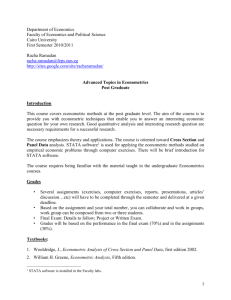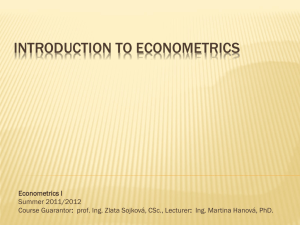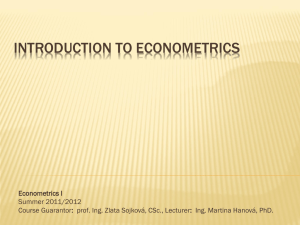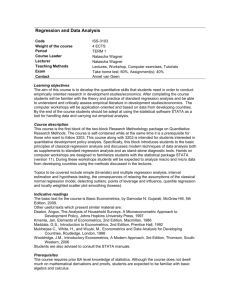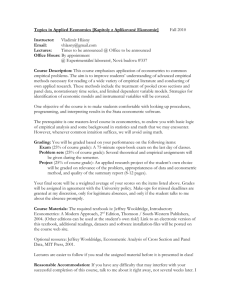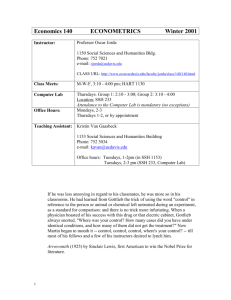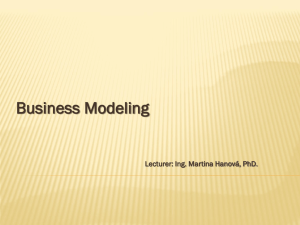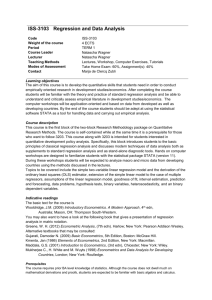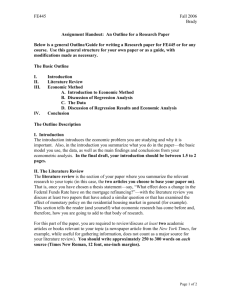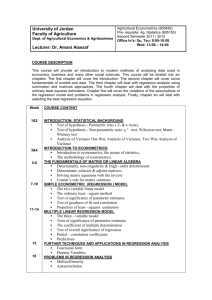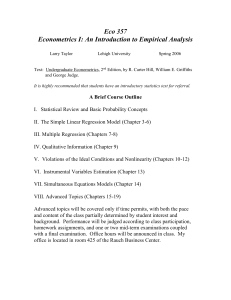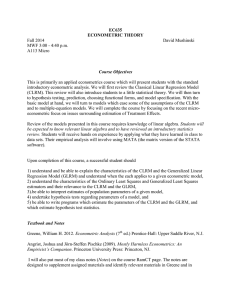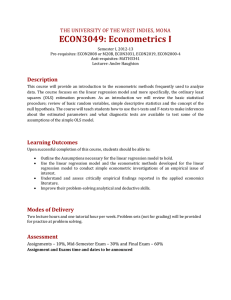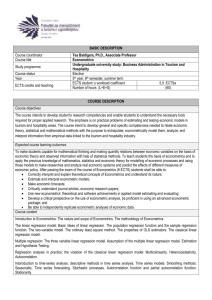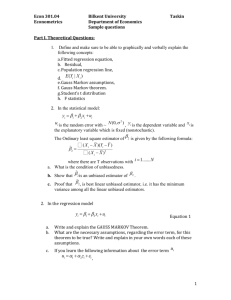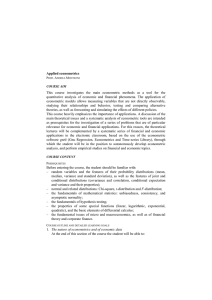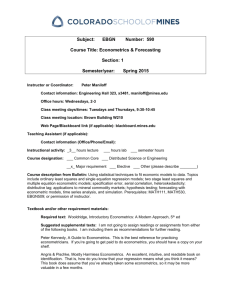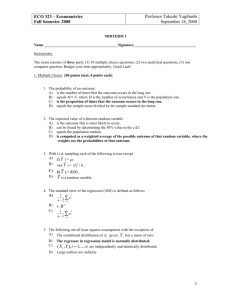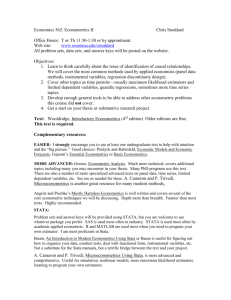Marketing Research
advertisement
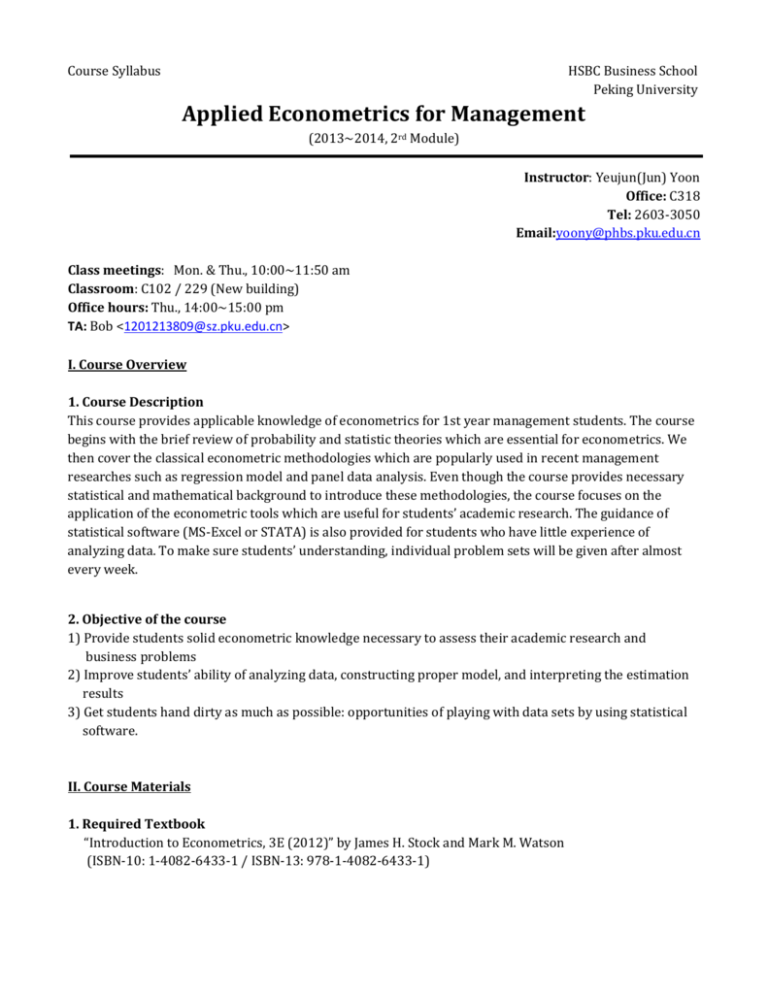
Course Syllabus HSBC Business School Peking University Applied Econometrics for Management (2013~2014, 2rd Module) Instructor: Yeujun(Jun) Yoon Office: C318 Tel: 2603-3050 Email:yoony@phbs.pku.edu.cn Class meetings: Mon. & Thu., 10:00~11:50 am Classroom: C102 / 229 (New building) Office hours: Thu., 14:00~15:00 pm TA: Bob <1201213809@sz.pku.edu.cn> I. Course Overview 1. Course Description This course provides applicable knowledge of econometrics for 1st year management students. The course begins with the brief review of probability and statistic theories which are essential for econometrics. We then cover the classical econometric methodologies which are popularly used in recent management researches such as regression model and panel data analysis. Even though the course provides necessary statistical and mathematical background to introduce these methodologies, the course focuses on the application of the econometric tools which are useful for students’ academic research. The guidance of statistical software (MS-Excel or STATA) is also provided for students who have little experience of analyzing data. To make sure students’ understanding, individual problem sets will be given after almost every week. 2. Objective of the course 1) Provide students solid econometric knowledge necessary to assess their academic research and business problems 2) Improve students’ ability of analyzing data, constructing proper model, and interpreting the estimation results 3) Get students hand dirty as much as possible: opportunities of playing with data sets by using statistical software. II. Course Materials 1. Required Textbook “Introduction to Econometrics, 3E (2012)” by James H. Stock and Mark M. Watson (ISBN-10: 1-4082-6433-1 / ISBN-13: 978-1-4082-6433-1) Additional reference * “Econometric Theory and Methods” (2004) by Russell Davidson and James G. MacKinnon, Oxford * “Microeconometrics: methods and applications” by A. Colin Cameron and Pravin K. Trivedi, Cambridge * “Marketing Research(2010)” by Aaker, Kumar, Day, and Leone, Willey III. Course Work and Grading 1. Course Assignments 1) Problem Set (6): Students solve the problem sets by using the technique learnt from the courses individually. Data would be given by instructor at the same day a problem set is distributed. You can use proper software to solve the problem set. The guidance for MS-Excel or STATA would be given during the class. Students must submit their final answers by deadline, the day BEFORE THE CLASS STARTS to TA. Paper version is strongly recommended! For special occasions, partial grade can be provided for late submission: however, you must get permission from an instructor first. 2) Project Assignment: Each student is required to choose his/her own research questions, construct the model, and conduct analysis to answer the research questions by using econometric techniques leant in the class. Each student must submit the final report by individual no later than deadline. Detailed guidance will be provided in the first class. You will present your work at the end of course < Criterion of Project Assignment > - How can your model answer your research questions? a) Whether your analysis tool (model & estimation method) is appropriate to answer your questions b) Whether your model is correctly specified c) How you interpret your results and defense your model * Additional points are given to whom provide meaningful comments to others’ presentation up to 10 points 3) Final Exam: there is a comprehensive class-room exam at the end of the semester. The exam will cover the materials only we discuss in the class. The review session might be given before the exam according to the course schedule. 2. Grading Category % Participation 10 Problem Sets 25 Project Assignment 25 Final Exam 40 IV. Class Participation You are required to be prepared and contribute regularly to our class discussion. Learning depends heavily upon thorough and lively participation and your preparation since I may from time to time call on individuals even when their hands are not raised. You should let me know before the start of class if some emergency has made it impossible for you to be prepared adequately for that class. V. Class Room Policies - Do not disturb other classmates with distracting devices such as cell phones and laptops. - Additionally, please display the name card. My classes are very interactive, and so it is important for me to know who you are. - Do not come to class late or leave early. Once the class starts you are expected to stay in your seat. Of course, I understand that there are special circumstances that can make this necessary; if you do need to come to class late, or leave early, please let me know ahead of time. - Finally, please remember that we have a strict academic dishonesty program here. For example, you need to be careful not to plagiarize from other sources. Failure to adhere to these policies will result in a failing grade. VI. Class Schedule* week Contents Reading(Text) ** 1 - Course description - Introduction of Econometrics Ch.1 2 - Review of Probability & Statistics Ch.2 3 - Review of Probability & Statistics Ch.2 4 - Sampling Distribution Ch.3 5 - Hypothesis Test I Ch.3 6 - Hypothesis Test II Ch.3 7 - Hypothesis Test III Ch.3 8 - Hypothesis Test IV Ch.3 9 - Linear Regression Model I Ch.4, Ch.5, Ch.17 10 - Linear Regression Model II Ch.6, Ch.7, Ch.18 11 - Linear Regression Model III Ch.8, Ch.9, Ch.18 12 - Linear Regression Model IV Ch.8, Ch.9, Ch.18 13 - Linear Regression Model IV Ch.9, Ch.12, Ch 15, Ch.18 14 - Panel Analysis I Ch.10 15 - Panel Analysis II Ch.10 16 - Panel Analysis III Ch.10 17 - Project Presentation 18 - Review Assignment Topics Probability & Distribution PS1 Joint Distribution Sampling Distribution Property of Estimator PS2 PS3 Hypothesis Test Intro Frequently Used Hypothesis Tests Frequently Used Hypothesis Tests ANOVA PS4 Single Regression Model Multiple Regression Model PS5 PS6 Model Specification & Issues in Regression Model Violation of OLS Assumptions Violation of OLS Assumptions Fixed Effect Model / Random Effect Model Fixed Effect Model / Random Effect Model Dynamic Panel Model Individual Presentation - * This Course schedule is tentative. (subject to change) ** Additional reference will be provided in the class if necessary


